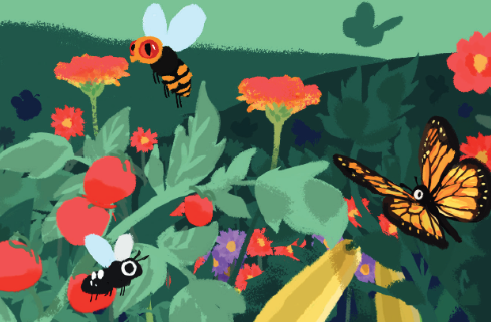O projektu
Why Cro Buzz Klima?
About 90% of flowering plants (about 308 thousand species) and more than 75% of agricultural crops depend on biotic pollination – transfer of pollen by animals. Pollination is the key process for seed and fruit development and for maintaining the genetic variability of plants. Genetic variability determines the adaptive potential of plant populations — that is, their ability to adapt to changes in the environment. This is why pollinators have a key role in enabling plant communities to adapt to climate change and other environmental changes. The value of ecosystem services provided by pollinators is estimated at € 15 billion per year in Europe alone.
Pollinators are receiving more attention in recent years due to scientific findings concerning the decline of their populations. Pollinator decline does not only mean the possible extinction of some insect species — due to the role they play in the ecosystem, the loss of pollinators can have a tremendous impact on food safety and the overall stability of terrestrial ecosystems.
Climate change is one of the main threats to pollinators, along with habitat loss, pesticides, pathogens, and invasive species. The climate crisis is the greatest challenge facing our world at the present moment, with catastrophic consequences for all parts of the ecosystem and human civilization. For pollinators and plants, climate change causes mismatches in time and space by shifting species distribution, plant flowering period, and the activity period of insects. Climate change can also directly affect pollinator species less tolerant to heat stress.
How can we help pollinators? First, we need to improve our knowledge about diversity, ecology, and the distribution of wild pollinators in Croatia, and about the impact that different factors have on their populations. We need to establish a monitoring system, allowing us to track changes in their populations. Such data are the basis for effective pollinator conservation, as they enable effective planning of land management, restoration, and climate adaptation measures. Collecting such data and conducting analyzes to answer these questions are some of the key activities of project Cro Buzz Klima.
- Albrecht, M., Schmid, B., Hautier, Y., & Müller, C. B. (2012). Diverse pollinator communities enhance plant reproductive success. Proceedings of the Royal Society B: Biological Sciences, 279(1748), 4845-4852.
- Biesmeijer, J. C., Roberts, S. P., Reemer, M., Ohlemüller, R., Edwards, M., Peeters, T., … & Kunin, W. E. (2006). Parallel declines in pollinators and insect-pollinated plants in Britain and the Netherlands. Science, 313(5785), 351-354.
- Klein, A. M., Vaissiere, B. E., Cane, J. H., Steffan-Dewenter, I., Cunningham, S. A., Kremen, C., & Tscharntke, T. (2007). Importance of pollinators in changing landscapes for world crops. Proceedings of the royal society B: biological sciences, 274(1608), 303-313.
- Lever, J. J., van Nes, E. H., Scheffer, M., & Bascompte, J. (2014). The sudden collapse of pollinator communities. Ecology letters, 17(3), 350-359.
-
Kudrnovsky, H., Ellmauer, T., Götzl, M., Paternoster, D., Sonderegger, G., & Schwaiger, E. (2020). Report for a list of Annex I habitat types important for Pollinators.
-
Martinet, B., Dellicour, S., Ghisbain, G., Przybyla, K., Zambra, E., Lecocq, T., … & Rasmont, P. (2020). Global effects of extreme temperatures on wild bumblebees. Conservation Biology.
-
Nieto, A., Roberts, S. P., Kemp, J., Rasmont, P., Kuhlmann, M., Criado, M. G., … & Michez, D. (2017). European red list of bees. IUCN.
-
Ollerton, J., Winfree, R., & Tarrant, S. (2011). How many flowering plants are pollinated by animals?. Oikos, 120(3), 321-326.
-
Ollerton, J. (2017). Pollinator diversity: distribution, ecological function, and conservation. Annual Review of Ecology, Evolution, and Systematics, 48, 353-376.
-
Potts, S. G., Dauber, J., Hochkirch, A., Oteman, B., Roy, D. B., Ahrné, K., … & Vujic, A. (2021). Proposal for an EU Pollinator Monitoring Scheme. EUR 30416 EN Ispra, 2021, JRC122225
-
Potts, S. G., Ngo, H. T., Biesmeijer, J. C., Breeze, T. D., Dicks, L. V., Garibaldi, L. A., … & Vanbergen, A. (2016). The assessment report of the Intergovernmental Science-Policy Platform on Biodiversity and Ecosystem Services on pollinators, pollination and food production.
Would you like to know more? Click here for recommendations of scientific articles on these topics.

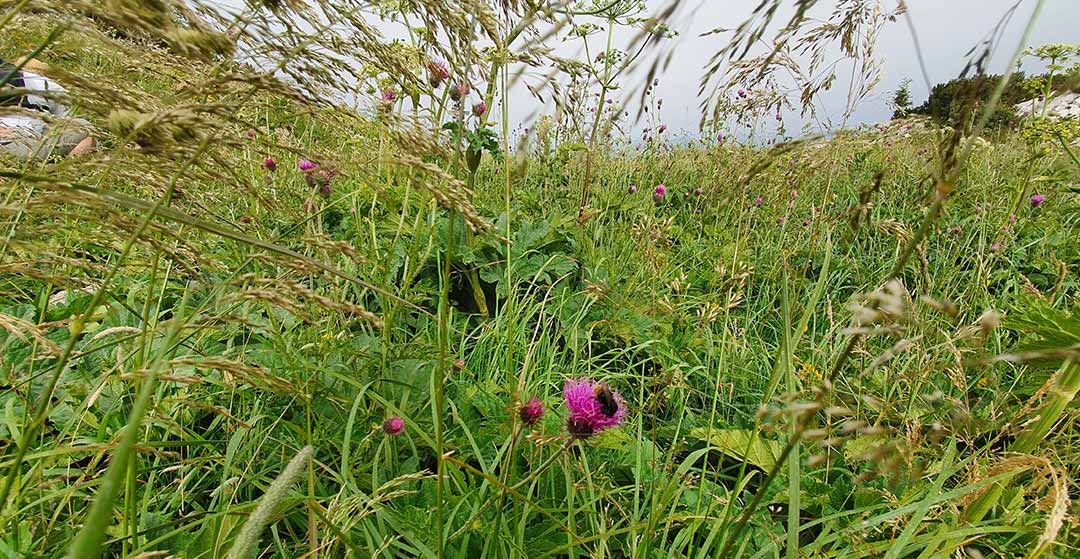
Project objectives
In addition to the importance and vulnerability of wild pollinators, the motivation for this project is the overall lack of data about wild pollinators in Croatia. Our project therefore aims to collect first standardized data about these two pollinator groups, conduct analyses, and identify measures for increasing their climate resilience in order to establish a foundation for future pollinator conservation. Given the current policies of the European Union, in which pollinators feature prominently and which raise climate ambitions, our project activities will also help us to meet environmental policy obligations to the European Union.
Project objectives of Cro Buzz Klima are:
-
- The collection of first standardized data on wild bees (Anthophila) and hoverflies (Syrphidae) of Croatia.
- Test the pollinator monitoring methodology proposed at the level of the European Union (EU Pollinator Monitoring Scheme).
- Determine the impact of climatic and other environmental factors on pollinator communities.
- Propose measures to increase the climate resilience of pollinator populations.
- Contribute to raising awareness of the importance of pollinators and climate change.
- Build capacities for pollinator monitoring and pollinator conservation in Croatia.
Project areas
Fieldwork is planned across five pilot areas, covering all three biogeographical regions of Croatia (continental, Alpine, and Mediterranean). We chose these areas because of their specific climatic conditions, because of their vulnerability to climate change, and/or because of habitat types that are particularly important for pollinators.
1.
City of Zagreb
Was chosen because cities can serve as a model for climate change. Temperatures in city centers are higher than at their periphery, a phenomenon known as the urban heat island effect. By comparing pollinator communities living in the city center with those living outside the center, we can determine how increased temperatures – and thus indirectly climate change – affect pollinator communities. In addition, research in other cities shows that urban areas can support diverse and rich pollinator communities. In Zagreb, we will explore which habitat characteristics of urban green spaces are most important for supporting rich pollinator communities. We need such knowledge for sustainable management of green areas of the city of Zagreb, for planning and development of ecological connectivity of the city (green infrastructure), and for faster adaptation of the city to climate change.
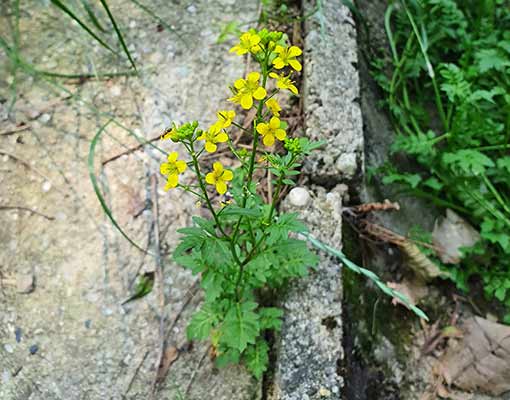
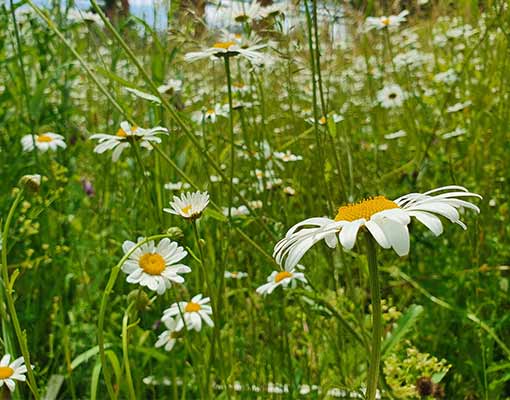


2.
Nature Park Žumberak – Samoborsko gorje
was chosen because of its diverse grassland habitats, highly ranked for their importance for pollinators in the Report on Natura 2000 pollinator habitats, due to high plant diversity. In the Park, we will establish a 2*2 km quadrant for testing the pan traps methodology proposed by the European Union pollinator monitoring program, as well as to sample pollinators across different habitat types.





3.
National Parks Plitvice Lakes and Risnjak
In the Alpine region of Croatia, we chose the National Parks Plitvice Lakes and Risnjak as pilot areas. Plant communities in mountain regions are considered as one of the most vulnerable ecosystems under the national Climate Change Adaptation Strategy. In this pilot area, we will focus on bumblebees, the genus Bombus. Bumblebees are the best-researched group of bees in Europe and are specialists of colder climates. Estimates of bumblebee species richness in Croatia are 30-40 species, with the highest expected diversity in the mountainous region, and high vulnerability to climate change.





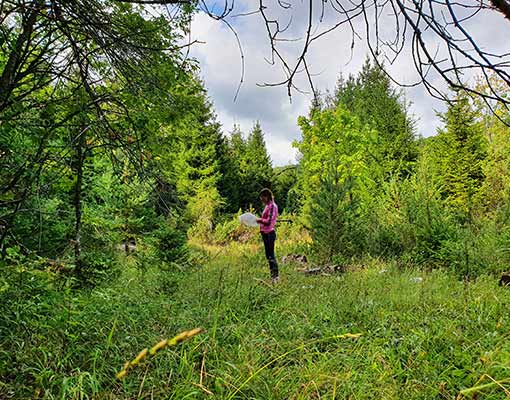
4.
Island of Krk
In the Mediterranean region, we selected the Natura 2000 site HR20001357 Island of Krk. Mediterranean habitats, especially dry grasslands, are sensitive to climate change due to changes in rainfall and temperatures, and due to changes in the abundance, community composition, and phenology of flower resources. Changes in the flowering period caused by climate change have a direct impact on pollinator species whose life cycle is closely linked to specific plant species. On Krk, we will establish a 2*2 km quadrant for testing the pan traps methodology proposed by the European Union pollinator monitoring program, as well as sample pollinators across different habitat types.





Research Methodology
Fieldwork
We will sample bees and hoverflies using standard methods, used in many other research studies and proposed for a pollinator monitoring program at the EU level. Collected data will enable us to determine species richness, diversity, abundance, and community composition of chosen taxa. In the field, we will also record climatic and ecological data at the sampling sites.
The pan traps method
is one of the two basic methods proposed by the EU pollinator monitoring program. The spatial basis is a LUCAS network of 2 km2 quadrants, across which 10 pan trap stations are set up diagonally, approximately at every 230 meters. A pan trap station consists of three pan traps, each of a different color (white, blue, and yellow). Pan traps are filled with water, placed on a stand, and left for 24 hours. Depending on the color, they attract and capture different insects. Sampling needs to be repeated several times during the season, to sample species active at different times of the year.




Transect walk method
In addition to pan traps, we will collect pollinators by hand, using the standard transect walk method. This method consists of walking a route of a certain length or walking within an area for a certain time (e.g., 30 minutes), recording all observed insects that can be identified on the wing, and netting those that one can not identify. This method allows a better estimate of pollinator abundance than the pan traps method, but can suffer from collector bias. Using both methodologies will allow us better estimates of species richness and abundance, and provide data statistically comparable with the future EU pollinator program.




FIT – count (Flower-Insect Timed count)
This method consists of counting flower visitors (insects that land on a flower) across an area of ½ m2, within 10 minutes. It provides us with an estimate of pollinator abundance and relative importance of different plant species for pollinators.

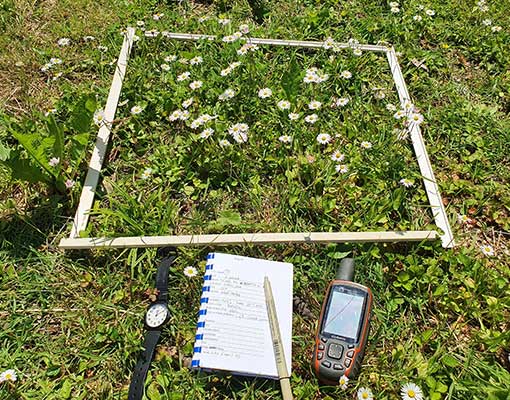
Climatic and ecological variables
In addition to pollinators, we will record various other ecological parameters such as diversity and abundance of flower resources, habitat type, management regime, soil and air temperature, etc. We will also use remote sensing data, i.e. data obtained from satellite images, for our analyses.
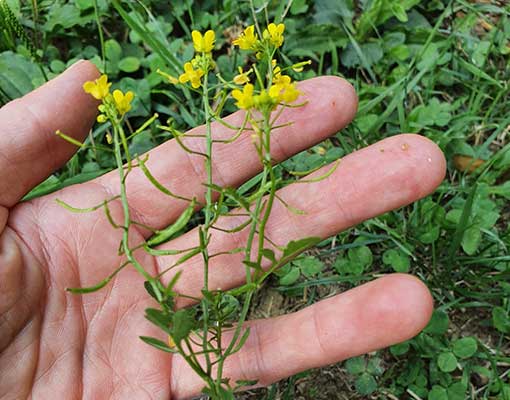

Results
Expected results:
1. Collection of the first standardized data on Croatian pollinators
-
- Species list of wild bees and hoverflies for pilot areas.
- Establishment of the project reference collection. Estimates of richness, diversity, and community composition of wild bees and hoverflies across different biogeographical regions and different habitat types.
2. Assessment of the impact of climate change and other factors on wild pollinator communities
-
- The influence of climatic and other environmental factors on wild pollinators.
- The influence of management on wild pollinators.
3. Two publications about pollinators in Croatia
-
-
A publication with a proposal of measures to increase climate resilience of pollinator populations.
-
A publication on pollinator plants for the city of Zagreb – a catalog of pollinator-friendly native plant species recommended for planting in city gardens.
-
4. Raising awareness about the importance of pollinators
-
- Educational talks on wild pollinators.
- Sharing information about pollinators on the Cro Buzz Klima website and via social media platforms.
5. Development of professional capacities for wild pollinators
-
- Developed expert capacities for the implementation of pollinator monitoring.
News
Find out the news about the Cro Buzz Climate project
SPRING final meeting
Last week we were in Bologna, attending the final meeting of the SPRING project partners. The main goals of this...
Policy buzz
This week European Commission announced the new EU Pollinator Initiative, the updated and strengthened version of...
Hoverfly taxonomy course
We spent the last week in Novi Sad, attending the advanced hoverfly identification course, organized within the...

